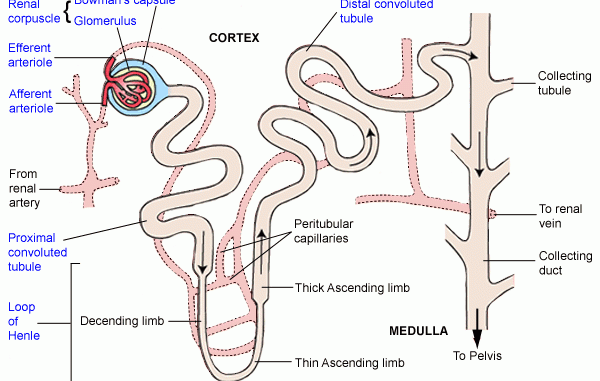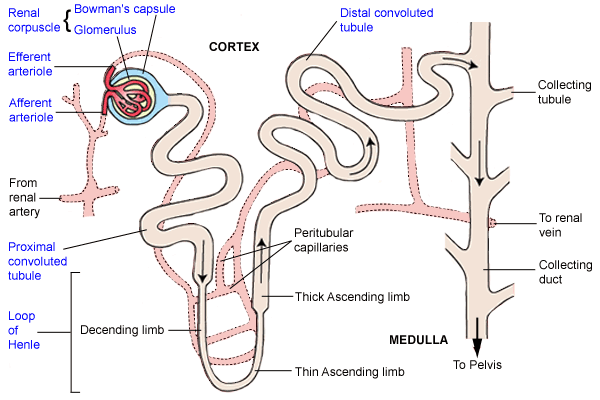
Nephron-Structural anatomy and types
- Histologically, each kidney is composed of approximately 1 million of Uriniferous tubules or nephron. Nephron is the structural and functional unit of the kidney.

Figure: Nephron- a functional unit of kidney
Each nephron has two major portions:
- A Renal corpuscle (Malpighian body)
- A Renal tubule
1. Renal corpuscles (Malpighian body):
- A renal corpuscle consists of a glomerulus surrounded by a glomerular capsule (Bowman’s capsule).
- The glomerulus is a capillary network that arises from an afferent arteriole and empties into an efferent arteriole. The diameter of the efferent arteriole is smaller than that of the afferent arteriole, which helps maintain a fairly high blood pressure in the glomerulus.
- Bowman’s capsule is double walled cup like structure and it encloses the glomerulus. The wall of glomerulus and the Bowman’s capsule consists of a single layer of flattened epithelial cells.
- Glomerular capsule consists of three layers
- i) Outer parietal layer consists of squamous epithelium cells with minute pore of 12nm diameter called fenestrations
- ii) Middle basement membrane which is selectively permiable
- iii) The inner visceral layer of large nucleated cell called podocytes. Podocytes bears finger like projections known as podocels. The areas between the two podocels is filtration slit underlying basement membrane.
2. Renal tubules:
- The renal tubule continues from Bowman’s capsule and consists of the following parts: proximal convoluted tubule (in the renal cortex), loop of Henle (in the renal medulla), and distal convoluted tubule (in the renal cortex).
- i) Proximal convoluted tubules (PCT): it is proximal part of renal tubules next to Bowman’s capsule. It is lined with microvilli. Maximum reabsorption of water, glucose, amino acids and electrolytes takes place here.
- ii) Loop of Henle: It is U shaped middle portion of renal tubules. It is composed of ascending and descending loop. Ascending loop is thick walled and impermeable to water while descending loop is thin walled and permeable to water. Counter current mechanism is crucial role of loop of Henle.
- iii) Distal convoluted tubules (DCT): It is the distal part of renal tubules that leads to collecting ducts. It is similar in structure and function with PCT.
- iv) Collecting tubules: It is not a part of nephron rather it is a part of kidney. The distal convoluted tubules from several nephrons empty into a collecting tubule. Several collecting tubules then unite to form a papillary duct that empties urine into a minor calyx and then into major calyx and finally into renal pelvis.
Types of nephron
- Cortical nephron: 80% of the nephrons are short and located within the cortex.
- Juxtamedulary nephron: 20% of nephron have long loops of Henle that extend into the medulla.
